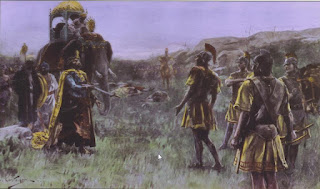As
mentioned in an earlier post (see: Alexander’s battle outfit),
the Macedonians basically used two types of swords. The straight sword with a
double-edged blade, which was most popular, was about 60-70 cm long. The blade was
exceptionally efficient because of the swelling toward the sword’s tip. It
added weight and momentum to each blow. It was used by cavalry and infantry
alike, as it functioned for hacking and stabbing.
The kopis, or
saber-shaped sword with the crooked hilt, was less common. The blade was 40-60 cm long, and only the
curved side had a cutting edge. The kopis was more effective for fights
on horseback since the rider could deliver a heavy blow from above.
Sources tell us that the
Cyprian King of Citium (ancient Larnaca) gave Alexander
a masterly executed sword, which was exceptionally light and well-tempered
(see: The role of Cyprus
in Alexander’s campaign).
Quality swords were widespread among Alexander’s commanders
and even common troops. Several memorable encounters have been reported by our
historians. The most striking one was when Cleitus, with a single blow,
severed the arm and shoulder of a Persian attacking Alexander at the Granicus. The Paeonian cavalry leader Ariston
used his sword to behead the Persian leader Satropates during a skirmish
near the Tigris River.
The kopis were handled by
the Macedonians at the Hydaspes to slash at the elephants’ trunks.
Ptolemy drove his sword through the thigh of a local chief during the
Indian expedition, and Alexander cut off the hand of his Arab
assassin with one stroke of his sword during the siege of Gaza. The Macedonian tradition
of handling weapons with high cutting capacity is still alive in 276 BC when King Pyrrhus inflicted such a blow to his adversary that he cleaved his opponent
in two parts, falling to either side!
Now we may wonder where and
how all these swords were made. Cyprus
was known for its quality weaponry, but did the artisans accompany the
Macedonians into Asia, or did they train a
selected number of people in this specific craftsmanship? Either theory is
plausible.
There is, however, the case
of Porus’ gift. After the Battle of the Hydaspes, King Porus gave Alexander a precious sword. This
story leads us to another source, Wootz Steel (the
name is a corruption of ‘ukku’), a well-kept secret amongst the
metallurgists in India.
The name first appeared when Alexander received a gift of over 2500 kg of ‘white iron’, a
kind of steel that originated in India
millennia before reaching Europe. Wootz
steel is a type of crucible steel made using a clay crucible. The
vessel was closed and heated for several days to a temperature of 1300-1400
degrees Celsius. In the process, the quality of the product acquired high
ductility, high impact strength, and reduced brittleness. After a slow cooling,
the Wootz ingots were ready. Archaeologists discovered an industrial steel
center from around the 3rd century BC in the southern state of Tamil
Nadu.
How
was this new technology received in the Macedonian camp? It is hard to imagine
that Alexander did not explore or use
the possibilities of this Wootz steel. He always was a ringleader when
confronted with new inventions and improvements in warfare. The next time we hear
about this revolutionary steel is that Indians had a monopoly over the
production and export of Wootz steel from the 3rd to the 17th
century, reaching from the Roman Empire in the West to China in the East.
In
the Middle Ages, Damascus became the main supplier of the famous Damascene swords, which is only another
name for weaponry made using Wootz steel.
By the 8th century, manufacturing in India
had spread throughout Central Asia, where the Vikings had established trade
posts to exchange their furs and slaves over Eurasia.
Hoards of Arab dirhams have been found in Scandinavia,
documenting these trades. As a result, by the 9th century, the
Vikings produced high-quality Ulfberht swords, made of crucible steel known as
Wootz steel.
The blades of Viking swords
were generally 70 to 90
centimeters long and 5-6 centimeters wide.
The so-called Ulfberht swords carried the inscription +VLFBERH+T, which may be
linked to some religious invocation rather than the maker’s signature. The
earliest known specimen was created in the 9th century and was one
of the heaviest (1.9 kg)
and longest (102 cm)
Viking swords. It is exhibited at the Museum
of Cultural History in Oslo. Another surviving
example is the sword of Saint Stephen from the 10th century, which
was the coronation sword of the Hungarian King Stephen. It still has its
walrus-tooth hilt.
The so-called Lincoln sword from the
same era is one of only two known swords bearing the inscription +LEUFRIT, also
made of crucible (most probably Wootz) steel. It was found near Monks Abbey in Lincolnshire, UK, in 1848.
It
is noteworthy that the science behind the production of Wootz steel was only
understood in the 20th century! From a technological point of
view, this means that the metallurgists of ancient India were far, really far ahead of
their time!
Unfortunately, history has, to my knowledge, not
linked the weaponry from Cyprus
to the Wootz steel swords made in India. Consequently, we still don’t
know how Alexander acted and reacted
to Porus’ highly prized gift. I can’t
imagine that Alexander did nothing to
explore this newly acquired knowledge.



No comments:
Post a Comment